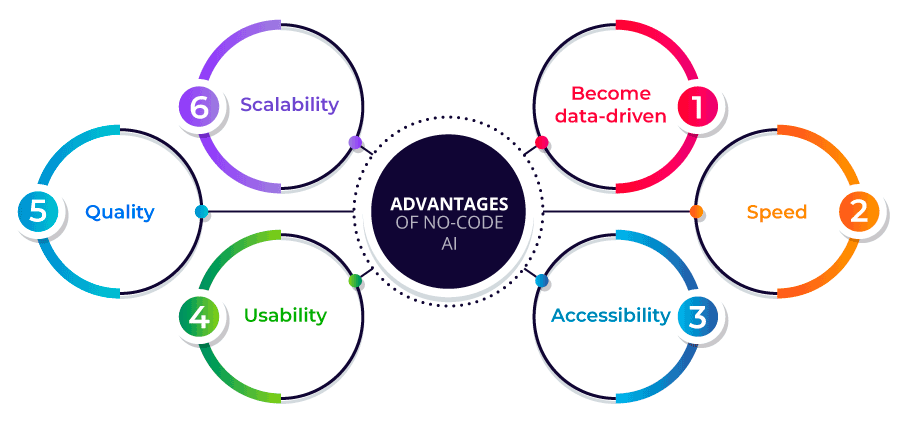
AI has been around for more than a decade, and some estimates claim it has finally reached critical mass. AI initiatives in most enterprises have moved beyond the experimentation and proof of concept stage. One thing that has steadily been on the rise is the investment and time needed for any AI initiatives to realize. AI is still considered a niche and technologically exhaustive.
Due to the right reasons, AI is still limited to a few who understand the technology and the associated complex terminology. Additionally, AI is extremely hard to master. If you wish to create a unique data model for your specific business problem, it may sometimes take months to arrive at a plausible working solution.
No-Code AI & Automation intends to address this prevalent and often taken-for-granted technical-functional gap.
Let’s start
What is No-Code?
Simply put, No-Code stands for a set of tools that empower regular users to build applications, automate workflows and manage data without having any programming knowledge. No-code is Lego of enterprise software, i.e., Plug and play, simple, easy, blocks or chunks of functionality.
No-code platforms, such as Quixy offer rich visual interfaces to build apps and pre-built integrations to connect with other enterprise systems as necessary. No-code platforms are targeted toward Business users who have the right context of the business problems to solve.
Also Read : Explore the Power of Artificial Intelligence: What AI can or cannot do?
The adoption of No-code platforms has been on the rise in enterprises over the years, and No-code is here to stay.
Before we delve into what No-code AI is all about, let’s first understand Why and When to use AI.
Also read: Everything you should know about No-Code Development
Now, what is AI?
A typical business application is generally a hotchpotch of complex processes governed by rules. Simply put, they are a bunch of if-else-then statements, also known as Rules, in various combinations. Rules give businesses the power to automate workflows at scale but only when the desired outcomes are predefined. What if the outcome cannot be preempted but is completely dependent on the data and its context?
For example, you wish to extract text from documents based on certain conditions, find the ideal marketing campaign strategy, or predict sales based on historical sales information & current market situation. These are the situations where AI comes to the rescue. According to Forbes, 83% of businesses say AI is a strategic priority for their businesses today. Rules can also handle these situations, but they would be inherently slow and unreliable.
Word of caution, AI is not the magic pill. What can be achieved with a few simple rules does not warrant the use of AI if the outcome is predetermined. With large data comes huge responsibility!
Also Read: AI Automation 101: What It Is & How Businesses Are Using It
Finally, What is No-Code Artificial Intelligence?
No-code AI and No-code share many similarities; they both empower business users to build applications or models in a fraction of the time and cost scale. So, No-code AI is here to democratize AI for users with no or limited technical know-how.
No-code AI aims to empower business users to create AI models and eliminate potential bottlenecks to adopting and leveraging AI in their business situations.
To understand how No-code AI can disrupt the seemingly elusive AI barrier for Businesses, let us first comprehend the traditional AI process.
Also Read: Async vs Sync: How Modern App Models Power Real-Time No-Code Innovation
Traditional AI is generally a 5-7 steps process starting from Data preparation, Feature engineering, Data pre-processing, Model selection, Hyper-parameter tuning, Model training, Model deployment, and finally, Workflow integration. These steps are generally non-linear in nature and take a lot of iterations to find the right combination of models and training parameters. Model deployment is another hassle that is time-consuming and expensive to set up and maintain. Traditional AI processes are generally slow to implement and need niche machine-learning & AI skills to build, deploy, and maintain.
Also Read: 15+ ChatGPT Prompts Tips to get the best results
Comparatively, the No-code AI process involves four steps: Data collection & upload, Drag & Drop model training, Results analysis, and Workflow integration. The great thing about No-code AI is the supporting elements, such as model selection, parameter tuning, training, model deployment, infrastructure, technical know-how, etc., are all handled by the No-code AI SaaS provider. This removes ~90% of hassles for the business users and significant savings on time and cost.
No-code AI / ML platforms allow users with no AI engineering skills to optimize operations and solve critical business issues with relative ease. No-code tag evidently means less intimidating technical jargon and more visual drag-and-drop tools to build robust models addressing any business issue. No-code is also a boon for any business that lacks resources or time to build ground-up AI systems.

Also Read: The Rise of Agentic AI: Why Enterprises Need Digital Co-Workers Now
Advantages of No-Code & AI
Let’s now look at a few additional advantages of No-Code AI

1. Become data-driven
According to Forbes, 83% of businesses say AI is a strategic priority for their companies today. There has been an increase in demand for AI talent in the market in the past two years. Building a data science team is both times consuming and expensive, especially when you are experimenting with being data-driven. No-code AI platforms or tools help you become data-driven without the data science team.
2. Speed
Experimentation and iteration are the key here. With No-code AI platforms, rapid model creation and testing are the norms. This allows for rapid model building and showcasing results to the business stakeholders more often for approvals or aiding in critical business decisions.
3. Accessibility
Due to relatively low upfront investment, flat learning curve, and no challenge of skill gap, No-code AI platforms mitigate the adoption of AI in small and medium-sized organizations. Additionally, No-code AI empowers business users to experiment with AI and realize its value faster.
Also Read: Caddie by Quixy: The AI Assistant Empowering Smarter Decisions
4. Usability
Drag-and-drop plug-and-play allows business users to build AI solutions quickly and cost-effectively. Since the target audience is non-technical business users, the platform is generally easy and self-serviceable.
5. Quality
With Business users as the target audience for the No-code AI tools, the risks with data are carefully thought out at the platform or product level. Measures such as Human-in-the-loop allow for fool-proofing the processes from unforeseen issues during regular operations.
6. Scalability
The underlying infrastructure comes with the No-code AI platform that automatically scales up or down based on a load of building and deploying models.
Conclusion
Quixy No-code AI process is simple, fast, cost-effective, and saves time by a big margin compared to a traditional AI process. No-code AI fosters innovation, a data-driven attitude, and faster decision-making in organizations without the need for expensive data science teams and large infrastructure.
No-code AI space is growing and has the power to transform any business. These platforms or tools remove the hurdle of upfront capital and a large data science team, which SMBs may find daunting to invest in, while also leveling the playing field against large enterprises.
Frequently Asked Questions (FAQs)
Q. Can anyone use No-Code AI tools without technical expertise?
Yes, No-Code AI tools are designed to be user-friendly, allowing individuals without technical expertise to easily create AI-driven solutions. These platforms offer intuitive interfaces and pre-built components, enabling users to build and deploy AI applications without writing complex code. This accessibility democratizes AI development, empowering a broader audience to harness the power of artificial intelligence for various use cases.
Q. What are the benefits of using No-Code AI in business?
No-Code AI offers several advantages for businesses. Firstly, it accelerates the development process, as it eliminates the need for extensive coding, allowing quick deployment of AI solutions. Secondly, it reduces costs and minimizes the need for hiring specialized AI developers. Additionally, No-Code AI enables non-technical teams to create AI applications tailored to their specific needs, enhancing operational efficiency and fostering innovation throughout the organization.
Q. Can No-Code AI tools integrate with existing software?
No-Code AI tools are designed to seamlessly integrate with existing software and applications. These platforms offer compatibility with various APIs and data sources, allowing businesses to leverage AI capabilities within their current systems without disruption. Integration with existing software enables organizations to enhance their processes, gain actionable insights, and improve decision-making using AI-driven insights.
Q. How secure are No-Code AI platforms?
No-Code AI platforms prioritize security to safeguard user data and maintain the privacy of sensitive information. These platforms implement industry-standard encryption protocols, secure data storage, and access controls to prevent unauthorized access. Moreover, reputable No-Code AI providers conduct regular security audits and updates to address potential vulnerabilities and ensure the platform’s reliability.
Q. Are there cost-effective No-Code AI solutions for startups?
Many No-Code AI solutions offer cost-effective options suitable for startups and small businesses. These solutions often offer flexible pricing plans, including free tiers or low-cost subscriptions, allowing startups to access essential AI capabilities without significant upfront investment. This affordability enables startups to experiment, innovate, and optimize their processes without incurring substantial financial risk.
Q. What are some practical examples of No-Code AI applications?
Practical examples of No-Code AI applications include creating AI-powered chatbots for customer support, automating data analysis and reporting, generating personalized product recommendations for e-commerce platforms, and building intelligent virtual assistants for various industries. These applications showcase No-Code AI’s versatility and real-world impact in streamlining tasks, improving user experiences, and driving business efficiency.
Q. Can AI No-Code be used for data analysis and predictive modeling?
AI No-Code platforms often include data analysis and predictive modeling capabilities. Non-technical users can explore and analyze datasets, create visualizations, and build predictive models using intuitive interfaces. These tools empower users to extract valuable insights from data without the need for specialized data science expertise, making data-driven decision-making accessible to a broader audience.
Q. Do No-Code AI platforms offer customization options?
No-Code AI platforms typically provide customization options, allowing users to tailor AI applications to their specific requirements. Users can customize workflows, interface elements, and model parameters to align with their business needs and industry-specific use cases. This flexibility ensures that the AI solutions built using No-Code platforms are optimized for the organization’s unique goals and preferences.
Q. How does No-Code AI empower citizen developers?
Artificial intelligence and no-code empowers citizen developers, individuals within organizations without formal coding backgrounds, to participate in AI development. These tools offer simple, visual interfaces that democratize AI development, enabling citizen developers to create AI applications tailored to their department’s needs. By reducing technical barriers, No-Code AI fosters a culture of innovation and collaboration, allowing diverse teams to contribute to the organization’s AI-driven initiatives.
Q. What future advancements can we expect in No-Code AI?
The future of No-Code AI holds exciting possibilities, with advancements in natural language processing (NLP), computer vision, and reinforcement learning. No-Code AI platforms are likely to become more sophisticated, offering more complex AI capabilities while maintaining their user-friendly nature. Additionally, we can anticipate improved integration with emerging technologies, making No-Code AI even more versatile and accessible across industries.
Login
Please login to comment
0 Comments
Oldest















